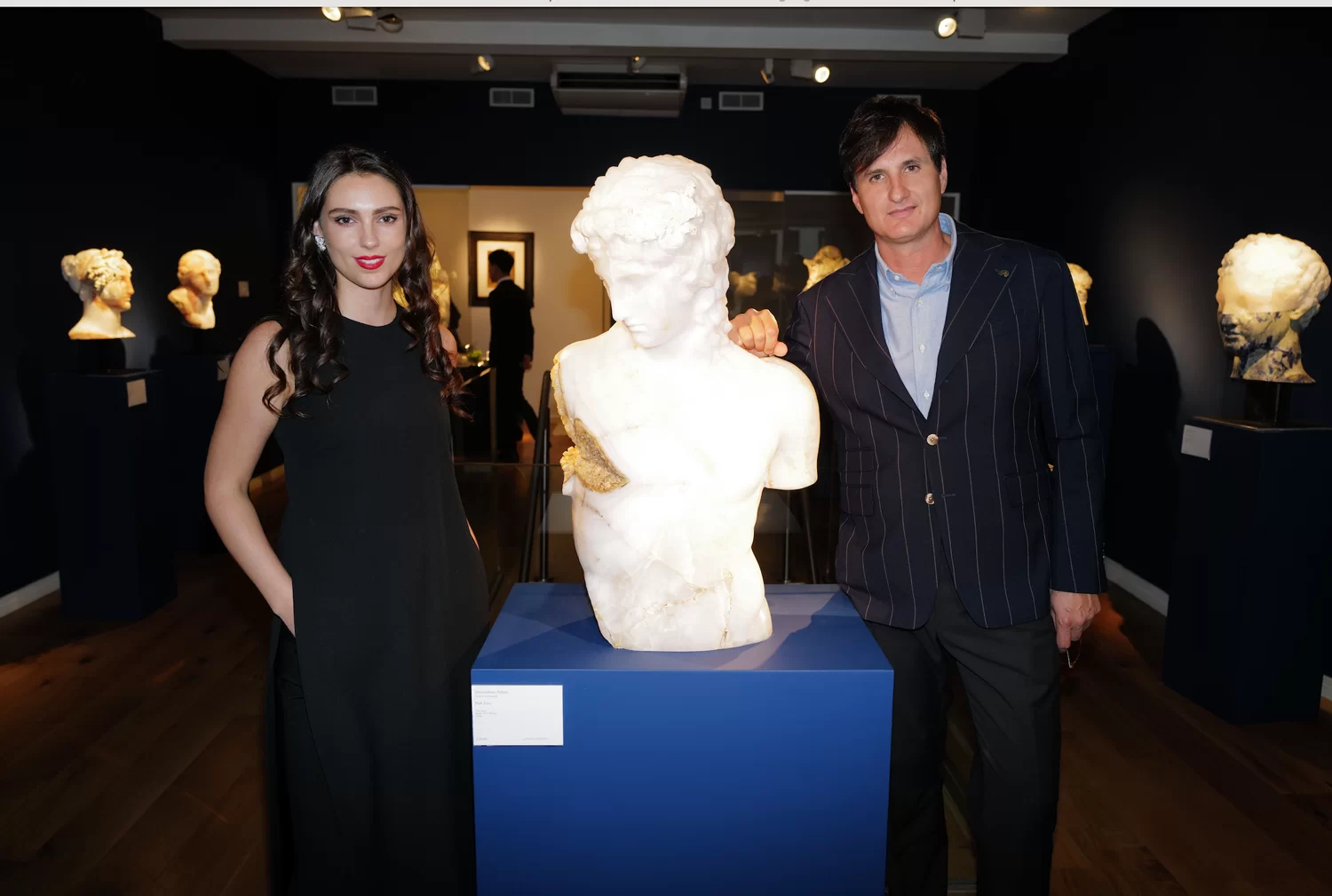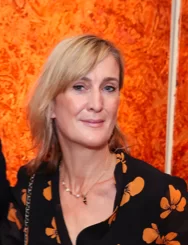Bowman Sculpture Gallery in Mayfair are presenting ‘Eredità’ (Heritage), the first UK solo exhibition of contemporary Italian sculptor Massimiliano Pelletti, which opened during Frieze Week and ends on 10 th November. Bowman Sculpture director Mica Bowman recently signed Massimiliano Pelletti for exclusive representation in the UK, and his ‘Eredità’ exhibition at the gallery precedes an exhibition at the Galleria at the distinguished Palazzo Doria Pamphilj in Rome, where Pelletti’s work will be exhibited alongside that of such artistic giants as Caravaggio, Titian, and Raphael – the first time that the museum has presented a contemporary artist alongside Old Masters, which highlights the calibre and importance of Pelletti as an artist.
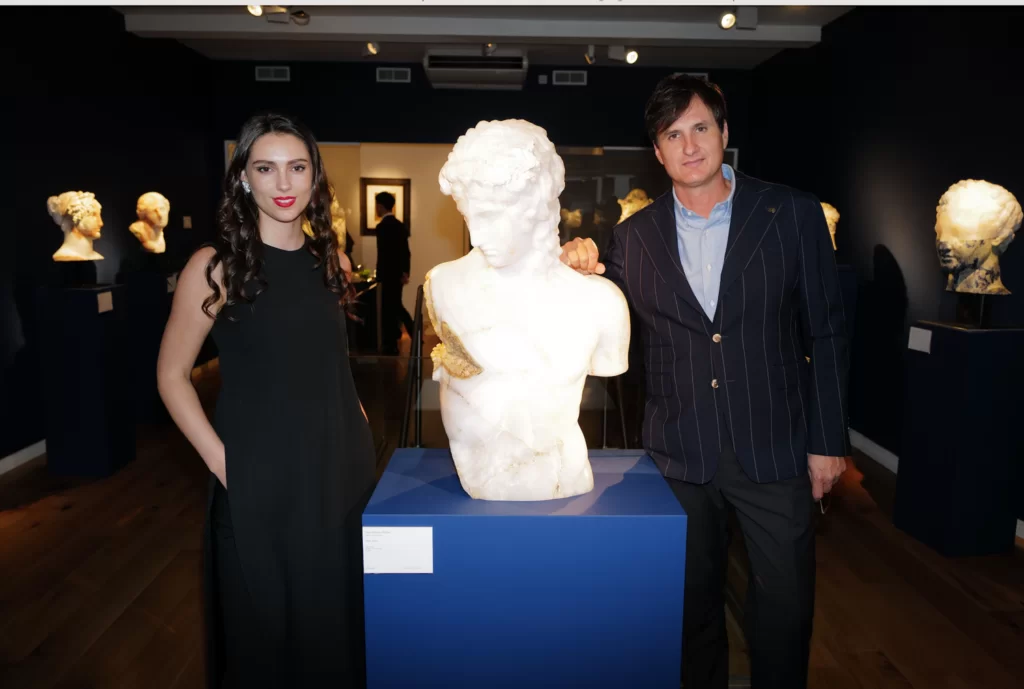
Copyright Bowman Sculpture
Massimiliano Pelletti (born. 1975) studied at the Stagio Stagi Art School in Pietrasanta, going on to graduate from the University of Pisa with a degree in Philosophy. He began a career as an artist in 2006, getting off to a flying start by winning the 12th edition of the Biennale of Young Artists from Europe and the Mediterranean, which led to high profile exhibitions in Italy and abroad, including the Alexandria Biennale in Egypt and the 54th Venice Biennale as part of the Italian Pavilion, curated by Vittorio Sgarbi.
‘Eredità’ is curated by Mica Bowman, whose exhibition recent all women show ‘The Power of She’ (co-curated with Marie-Claudine Llamas of Guerin Projects) received a warm reception in the spring and was featured in Forbes as an‘Essential Highlight of International Women Artists’ Art Week’ and by the Evening Standard as a highlight of London Gallery Weekend.
‘Eredità’ plays on the theme of heritage and the artisanal legacy Pelletti is continuing with his expert knowledge of the art of direct stone carving, a traditional and increasingly rare skill that Pelletti inherited from his grandfather Mario. Massimiliano was educated from a young age in the art of stone carving, spending much of his childhood in his grandfather’s studio surrounded by plaster models of ancient sculptures.
Lee Sharrock interviewed Pelletti and Bowman for Art Plugged:
Lee Sharrock: Massimiliano Pelletti is the second contemporary sculptor you have signed to Bowman Sculpture since you became a director of the gallery in 2019. What was it about his sculpture that made you want to work with him, and how did you discover him?
Mica Bowman: I discovered Massimiliano’s work through social media. I quite often receive messages and requests from artists who are looking for gallery representation, however, on this occasion, I was the one who initially followed his account. I followed him for some time before getting in touch, to get an idea of his consistency and to see how the works changed over time. I also explored his website and investigated his exhibition history, technique, and previous education. I was impressed and fell completely in love not only with his sculpture but with his story and his practice.
The contemporary twist on antiquity, the exploration of flaws within subjects grounded in the idealism of antiquity and of course his dedication to the tradition of stone carving was something I thought was unique and enthralling. I wrote to him and asked if I could come and meet him in his studio in Pietrasanta. Visiting his studio only encouraged my new obsession and we quickly started discussions as to how we could work together going forward.
After seeing the works in person, I knew that he was a very special artist. I thought to myself, this is someone who is working in a traditional style, using traditional carving techniques and I have never seen someone who can carve, by hand, as expertly as the ancient stone carvers. When you think about it, there were undoubtedly hundreds of stone masons and artisans working throughout history who were producing sculptures of this calibre. However, these days, true masters are few and far between.
Lee Sharrock: You are quoted as saying about Pelletti: “Through his meticulous craftsmanship and thought-provoking compositions, Pelletti unveils a nuanced exploration of time, imperfection, and our collective fascination with bygone eras.” Why do you think the younger generation of artists and collectors are still interested in classical forms and iconic imagery from antiquity?
Mica Bowman: I think that the aesthetic and artistic principles that were developed in ancient Greece and Rome continue to captivate people because they are rooted in universal concepts of beauty, balance, and proportion. Massimiliano challenges these concepts by juxtaposing classical beauty with the inherent flaws of the natural materials he works in and by layering those materials to create something entirely new. This juxtaposition and layering technique create something quite special, as it manages to bridge the gap between the old and the new. I think his works will resonate with the younger generation’s desire for exploration and pushing the boundaries of artistic expression, creating a dialogue with the past while making their mark on the present.
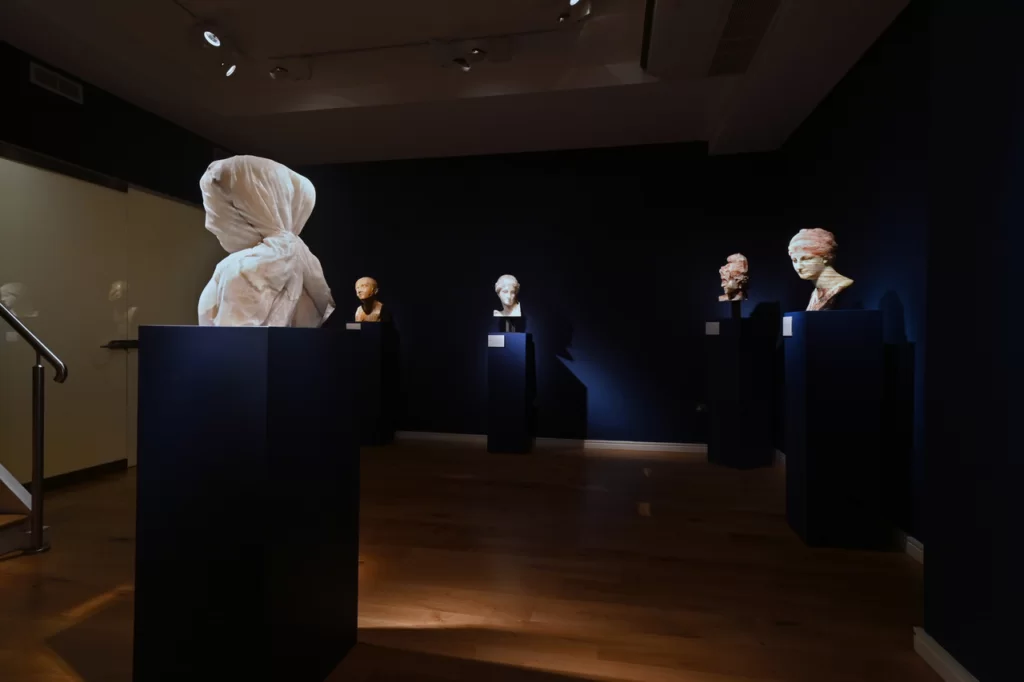
Copyright Bowman Sculpture
Lee Sharrock: Pelletti carves each of his sculptures by hand from a solid block of stone, whereas nowadays the majority of contemporary sculptors use computers to create laser-cut stones and/ or 3D printing. What do you think is the enduring attraction of hand-carved sculpture in an age of new technologies such as AI and computer-generated art?
Mica Bowman: I believe that the enduring attraction of hand-carved sculpture lies in its unique tactile nature, in the experience of craftsmanship, authenticity, tradition, emotional depth, distinctive aesthetics, and its ability to provide a counterbalance to the digital world. Hand-carved sculptures are celebrated for their one-of-a-kind nature, the rich they represent, and the emotional connection between the artist and the medium, offering viewers a respite from the increasingly digital and mass-
produced art landscape.
Lee Sharrock: You have titled this first solo show in England ‘Eredità’. How did you select the work to exhibit at Bowman Sculpture, and what is the meaning behind the exhibition title?
Massimiliano Pelletti: In this my first solo exhibition in England I have selected a group of 25 sculptures, that represent a cross-section of my work and research. Working with such a large number of artworks has allowed me to work with a wide section of materials and to explore much of my formal research. The title Eredità was inspired by my family, whose origins have been connected for many years to the tradition of sculpture, and by my native home, Pietrasanta in Tuscany, a place
that has long been devoted to sculpture due to its proximity with the marble quarries.
Lee Sharrock: After your exhibition opens in London at Bowman Sculpture, you will be exhibiting at the distinguished Palazzo Doria Pamphili in Rome alongside giants of art history including Caravaggio, Titian, and Raphael.
Massimiliano Pelletti: This juxtaposition of contemporary sculpture with Old Masters is a first for the Doria Pamphili museum, and demonstrates your importance as an artist. Were these artists inspirations for your work, and how does it feel to have your sculptures juxtaposed with such artistic giants?
Lee Sharrock: The project I have been working on for the Galleria Doria Pamphili is based on the richness of its exhibition spaces. I am trying to include some artworks that have been specially conceived for the location and intend to exhibit works that relate to different stone materials that are present in the Museum’s architecture.
Massimiliano Pelletti: The selection of artworks that are on display in the Museum is considered to be world heritage and the museum is home to the work of Italian art Masters that I studied during my education. To have my sculpture alongside these great masters is something that fills me with pride and empowers me to carry on producing my work to a high standard and with the utmost exploration and professionalism.

Copyright Bowman Sculpture
Lee Sharrock: You come from an esteemed family of stone carvers in Italy, and your grandfather famously worked on the restoration of Michelangelo’s ‘Pietà’ at the Sistine Chapel. At what age were you introduced to the art of stone carving, and how did you adapt the skills passed down through generations of your family to a contemporary art audience?
Massimiliano Pelletti: Yes, as a child I had the chance to go to my grandfather’s studio and listen to him tell these amazing stories about when he was working on the restoration of Michelangelo’s Pietà, or how he realized an official copy from the plaster model coming right from the Vatican that the Vatican sent to Colombia. So, within the studio, little by little my passion for sculpture was born as a game and, supported by my studies, became a profession. At last, what I did was to take something that belonged to me from the origins of myself and my family and reinterpret it in a contemporary way.
Lee Sharrock: Your sculptures are inspired by Greek and Roman antiquity, yet you give each piece a distinctly contemporary twist. Could you explain a bit about your process, your starting point and inspiration, the materials you use and the technique?
Massimiliano Pelletti: In my work, my passions revolve around, art, sculpture, archaeology, geology, and history. Usually, when I realize an artwork, I never start with the subject and there are no set projects; my creations always start from the material. I look for a material according to its geological characteristics and its composition; the moment I find something interesting I start thinking about how it could be used suitably to create a sculpture.
So, both the material and I together become the author of the artwork and the finished result is always partially determined by what I wanted to do, and what the material allowed me to do. I find this method stimulating because there is always a component of uncertainty that remains during the process and it is this that makes each artwork truly unique because it is actually unrepeatable.
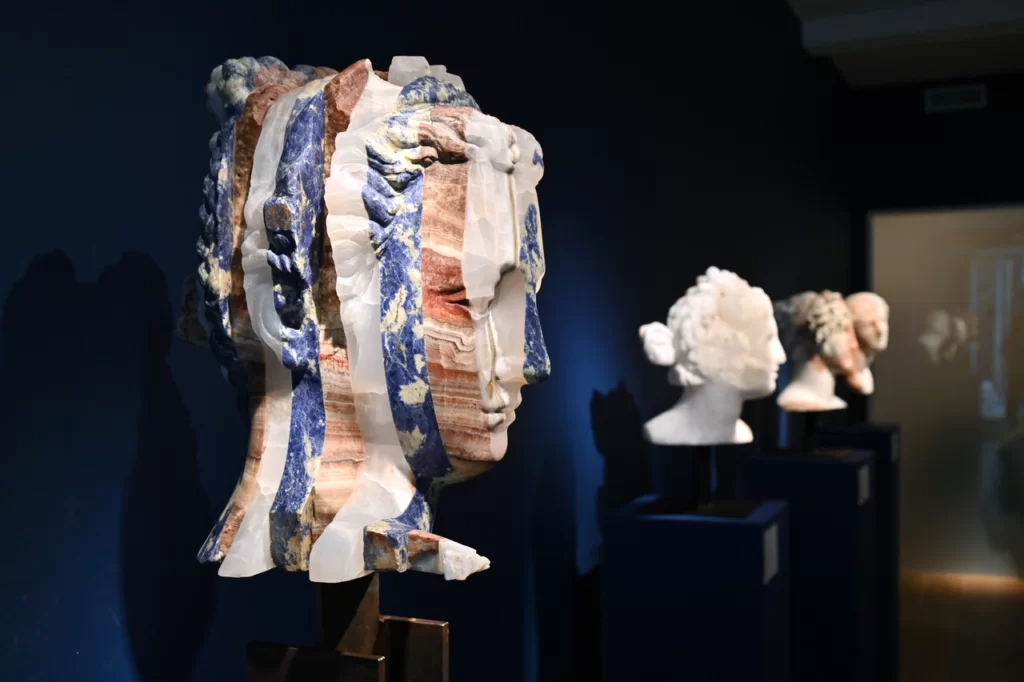
Copyright Bowman Sculpture
Lee Sharrock: After studying at the Stagio Stagi Art School in Pietrasanta, and later graduating from the University of Pisa with a degree in Philosophy, you embarked on a career as an artist in 2006. Not long after starting out as an artist, you won the 12th edition of the Biennale of Young Artists from Europe and the Mediterranean, which led to high-profile exhibitions in Italy and abroad, including the Alexandria Biennale in Egypt and the 54th Venice Biennale as part of the Italian Pavilion. Were you
surprised by the rapid ascent of your art world star, and how did inclusion in such significant Biennales and international exhibitions impact your career?
Massimiliano Pelletti: I always made art but I just didn’t have the heart to show the public what I did. During my University studies, I showed my artworks to a history of aesthetics professor. She was the one who pushed me to take part in this important competition, the “Biennale del Mediterraneo” where I was eventually selected. Since then, a series of important exhibitions have followed.
To be honest, throughout my career, I was focused on research and the development of my work. Just a few days ago I was talking with my aunt, the daughter of my grandfather who was a sculptor and, very proudly, she asked me how I had gotten to this point in my career; I sincerely thought about it and then I replied: “I don’t even know, I found myself there without even noticing”.
Massimiliano Pelletti ‘Eredità’ is at Bowman Sculpture Gallery, 6 Duke Street, St. James’s, London SW1Y 6BN, until 10 th November.
©2023 Bowman Sculpture Gallery


